Les plantes et les personnes dans les espaces verts urbains (PAPPUS)
Marco Moretti, WSL (Project leader)
Marcel Hunziker, WSL (Deputy)
Lauren M. Cook, Eawag
Bertrand Fournier, Potsdam Universität
2023 - 2027
FinancementComment les facteurs humains et biophysiques façonnent conjointement la biodiversité et ses avantages pour l'homme dans les villes ¶
Face à des pressions telles que la densification urbaine, la perte de biodiversité et le changement climatique, il existe un consensus croissant sur la nécessité de transformer les villes pour restaurer la biodiversité, réguler le microclimat et améliorer la qualité de vie des êtres humains. Les espaces verts urbains, tels que les parcs et les jardins privés, peuvent contribuer à la réalisation de ces multiples objectifs, principalement en raison des propriétés et des types de végétation qui y poussent. Cependant, les mécanismes qui sous-tendent la composition des communautés végétales en milieu urbain restent en grande partie méconnus, principalement en raison de la nécessité d'une meilleure compréhension des interactions entre les facteurs biophysiques et les influences humaines qui influencent la structure et la diversité des assemblages végétaux en milieu urbain. En conséquence, la gestion de la diversité, de la composition et des attributs des plantes dans les espaces verts urbains demeure un domaine d'étude peu exploré. Cette situation limite notre capacité à tirer parti des avantages humains et écologiques potentiels, tels que la provision d'un habitat pour les insectes et la régulation de la température. Pour comprendre comment ces bénéfices sont réalisés, il faut une approche interdisciplinaire qui prenne en compte les processus sociaux et écologiques sous-tendant la prise de décision des parties prenantes.
Objectif et questions de recherche ¶
L'objectif du projet PAPPUS1 est de comprendre comment les responsables (par exemple, les propriétaires et les gestionnaires d'espaces verts publics et privés, les jardiniers et les non-professionnels) affectent les assemblages de plantes présents dans différents espaces verts urbains, et comment leurs décisions affectent les bénéfices écologiques et humains qui peuvent être tirés des espaces verts urbains. Ceci dans un contexte caractérisé par la densification urbaine, la perte de biodiversité et le changement climatique, afin de proposer des mesures durables pour répondre au mieux aux défis actuels et futurs des villes.
Nous atteindrons cet objectif en examinant les facteurs humains et biophysiques qui déterminent les décisions de planter certaines espèces dans les espaces verts urbains privés, semi-publics et publics. Il est particulièrement important de savoir si ces décisions peuvent être influencées par des facteurs externes (par exemple, la préférence du public ou la connaissance de la crise de la biodiversité et du changement climatique) et comment les décisions ainsi influencées modifieraient la composition fonctionnelle des assemblages de plantes dans les espaces verts urbains en fonction du climat actuel et futur et des scénarios de densification urbaine.
_______
1Le pappus est l'appendice léger et plumeux de certains fruits ayant pour fonction de favoriser la dispersion des graines par l'action du vent, comme chez le célèbre pissenlit (Taraxacum officinalis).
PAPPUS examinera les quatre questions de recherche suivantes :
- Quelles plantes les responsables décident-ils d'acheter et de planter, et comment les gèrent-ils, compte tenu des préférences des parties prenantes et d'autres groupes, et de différentes considérations externes?
- Quelles sont les plantes qui poussent dans les différents espaces verts urbains et comment affectent-elles la biodiversité des insectes et les bénéfices pour l'homme?
- Comment les plantes cultivées dans les espaces verts urbains affectent-elles le microclimat local et comment le climat affecte-t-il ces plantes?
- Quelles plantes pousseront dans ces espaces verts urbains à l'avenir, selon différents scénarios, et comment cela modifiera-t-il les bénéfices écologiques et humains?
Conception du projet ¶
Le projet a débuté en 2023 et se poursuivra jusqu'en 2027. Trois villes suisses (Lugano, Genève et Zurich) sont impliquées, représentant trois régions biogéographiques, langues et contextes socioculturels différents. Le projet se concentre sur les principaux types d'espaces verts urbains (jardins privés, jardins familiaux, parcs, propriétés immobilières et zones rudérales), avec un total de 60 sites par ville et 180 sites au total (voir figure 2).
Ces questions de recherche sont abordées dans le cadre de leurs modules de travail (WP) respectifs (voir la figure 3), à savoir Society (WP1), Biodiversity (WP2), Microclimate (WP3) et Integrated Scenarios (WP4):
WP1 Society (Dr. Marcel Hunziker, WSL) évalue les préférences et les comportements liés aux plantes2 des personnes responsables de divers espaces verts urbains en Suisse.
WP2 Biodiversity (Dr. Marco Moretti, WSL) examine comment les décisions de plantation et de gestion, ainsi que les facteurs biophysiques, influencent les assemblages végétaux actuels, la biodiversité des insectes et les bénéfices pour l'homme dans différents espaces verts urbains.
WP3 Microclimate (Dr. Lauren Cook, Eawag) explore comment les caractéristiques et les assemblages de plantes affectent la régulation thermique dans les espaces verts urbains dans un climat suisse actuel et futur.
WP4 Integrated Scenarios (JProf. Bertrand Fournier, University of Potsdam) quantifie et modélise la réponse des assemblages de plantes en fonction de leurs caractéristiques et des bénéfices écologiques et humains associés.
______
2Nous utilisons le terme « lié aux plantes » pour couvrir les préférences et les comportements concernant les espèces, les caractéristiques et les assemblages de plantes.
Pertinence scientifique et sociale ¶
L'originalité de PAPPUS réside dans la forte intégration de théories et de méthodes issues des sciences sociales, de l'écologie et de la climatologie. Le projet adopte une approche de modélisation mécanistique et prédictive qui utilise les caractéristiques des plantes pour quantifier et évaluer les préférences sociétales et les pratiques de gestion liées à la végétation dans différents espaces verts urbains, ainsi que leurs effets sur la biodiversité, le microclimat et les bénéfices pour l'être humain. Cette démarche nous permettra d'acquérir les connaissances sociales, écologiques et microclimatiques indispensables pour garantir que les espaces verts urbains continuent à fournir des bénéfices essentiels face aux changements climatiques, à la perte de biodiversité et à la densification urbaine, tout en répondant aux besoins distincts des plantes, de la biodiversité et des êtres humains.
Progrès du projet ¶
Activités 2023: Nous avons sélectionné 60 espaces verts urbains dans chacune des trois villes. Dans chacun d'entre eux, nous avons effectué des relevés de végétation, tandis que dans 15 d'entre eux (5 par ville), nous avons mesuré les variables microclimatiques pertinentes. Nous avons également interrogé une sélection représentative de propriétaires et de gestionnaires de ces espaces verts. Nous avons obtenu des fournisseurs de plantes des listes d'espèces disponibles dans le commerce qui, avec les espèces indigènes présentes en Suisse, forment le pool global de plus de 4 000 espèces qui sera utilisé pour étudier les critères de sélection des différents décideurs.
Activités 2024: Dans 60 espaces verts de la ville de Zurich, nous avons prélevé des échantillons d'insectes liés aux plantes et collecté des fleurs et des feuilles pour analyser leur composition chimique. Nous avons préparé l'enquête sociologique à réaliser auprès des 180 propriétaires et gestionnaires d'espaces verts et à l'échelle nationale. Nous avons commencé la modélisation du microclimat et recueilli des données supplémentaires sur le microclimat dans 15 espaces verts de la ville de Zurich. Avec les données sur toutes les plantes en Suisse et sur le marché, nous avons finalement analysé quelles espèces sont présentes dans la ville et pourquoi.
Vous voulez en savoir plus ? ¶
- Consultez notre enquête sur ce qui fait la beauté d'une plante: https://www.biodiful.org/#/plantiful_de
- Consultez les données sur le microclimat pour une sélection d´espaces verts dans les trois villes: https://pappus.eawag.ch/
- Télécharger le Dépliant

Collaborateurs ¶
Aline von Atzigen, postdoctorante, WSL
Joan Casanelles Abella, postdoc, TUM
Vivien Grothe, étudiante PhD, Université de Potsdam
Louise Daedlow, étudiante en PhD, Université de Potsdam
Sebastian Richard Ruile, étudiant PhD, WSL-ETHZ
Yuxin Yin, PhD student, Eawag-EPFL
Fengge Liu, assistante de recherche, , Eawag
Merin Reji Chacko, postdoc, WSL
Arturo Knecht, assistant de recherche, WSL
Alessandra Knuser, assistante de recherche, WSL
Partenaires de recherche ¶
Jaboury Ghazoul, EPFZ, Zurich,
Terry Hartig, Université d'Uppsala, Suède,
Prof. h.c. Dr. Anna Hersperger, Institut fédéral suisse de recherche WSL
Prof. Gabriele Manoli, École polytechnique fédérale de Lausanne EPFL
Dr Nicolas Mouquet, CNRS, Montpellier, France



